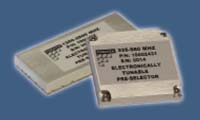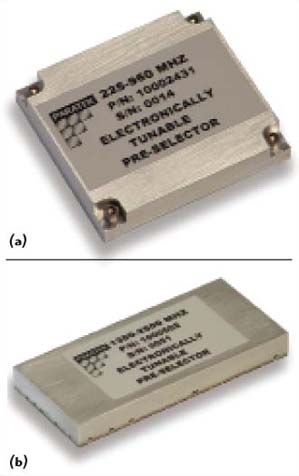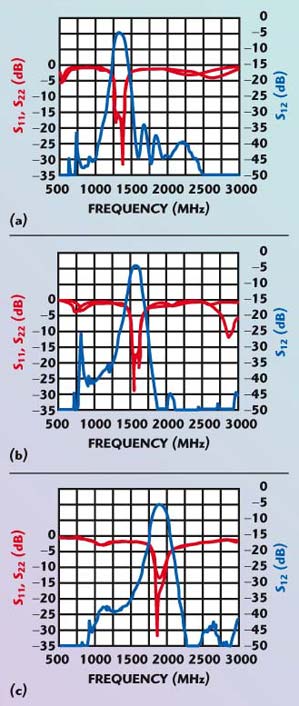
A multi-band, multi-waveform software defined radio (SDR) that provides programmable and re-configurable communications is at the core of ad-hoc networks, and ad-hoc networks are key to the transformational needs of the military (manned and unmanned). To meet interoperability requirements and mitigate co-site interference issues of a multi-band, multi-waveform architecture, the hardware solution must be modular and frequency agile. Whether a super-heterodyne or a direct conversion transceiver (NZIF or ZIF) is used, filters are required in the front end for discriminating in-band and out-of-band signals. When the need for multi-band operation is added, the only solution for front end filtering is to use electronically tunable pre-selectors.
Electronically tunable pre-selectors offer frequency agile selectivity with reduced part counts over fixed filter approaches. Specifically, electronically tunable pre-selectors must be able to tune a narrow pass band over a wide frequency range, have low insertion loss, minimal group delay, fast and precise tuning (microseconds), minimal amplitude variation, and low power consumption (milliwatts). In addition, they must be small in size and weight while being able to handle high RF power.
Paratek Microwave Inc. has developed a family of electronically tunable pre-selectors, based upon their proprietary Parascan™ thin films, which have demonstrated all of the foregoing characteristics. These filters have been integrated and tested in DoD radios and have proven to be very reliable, a key requirement for use in SDRs.
Using Parascan thin film tunable capacitors, a series of compact wideband electronically tunable pre-selectors has been developed that tune center frequencies from 225 to 960 MHz and 1350 to 2500 MHz (see Figure 1), while maintaining good frequency response. The center frequency of the pre-selectors is tuned continuously across the operating band by applying a DC voltage to the thin film dielectric. The dielectric constant of the film can be decreased by nearly an order of magnitude, changing the high frequency wavelength in the microwave device. Parascan thin film technology allows microwave devices that have very low power consumption and are compact, lightweight, simple, robust, planar, voltage tunable and affordable.

Fig. 1 Electronically tunable pre-selectors with integrated controllers; (a) 225 to 960 MHz and (b) 1300 to 2500 MHz.
The tunable pre-selector circuits consist of three-pole loaded L-C resonators or mixed lumped and distributed element resonators optimized for the bands of interest. Figure 2 illustrates typical pre-selector performance for pass band, insertion loss and return loss at the low, mid and high end of the 225 to 960 MHz operating band. Figure 3 shows the same performance parameters for the low, mid and high end of the 1350 to 2500 MHz operating band. These figures illustrate how an application of a DC bias voltage onto the tunable capacitors causes the center frequencies to shift.

Fig. 2 Typical pre-selector performance at the (a) low, (b) mid and (c) high end of the 225 to 960 MHz operating band.

Fig. 3 Typical pre-selector performance at the (a) low, (b) mid and (c) high end of the 1350 to 2500 MHz operating band.
Smart controllers are embedded in the tunable pre-selector to provide communication interface to the radio and detailed frequency calibration over temperature. The calibration feature provides highly accurate frequency settings and optimum pre-selector performance at all operating temperatures. The smart controller also supports bi-directional handshaking for continuous remote monitoring of communication fidelity. Table 1 lists some of the key performance specifications of the electronically tunable pre-selectors.
